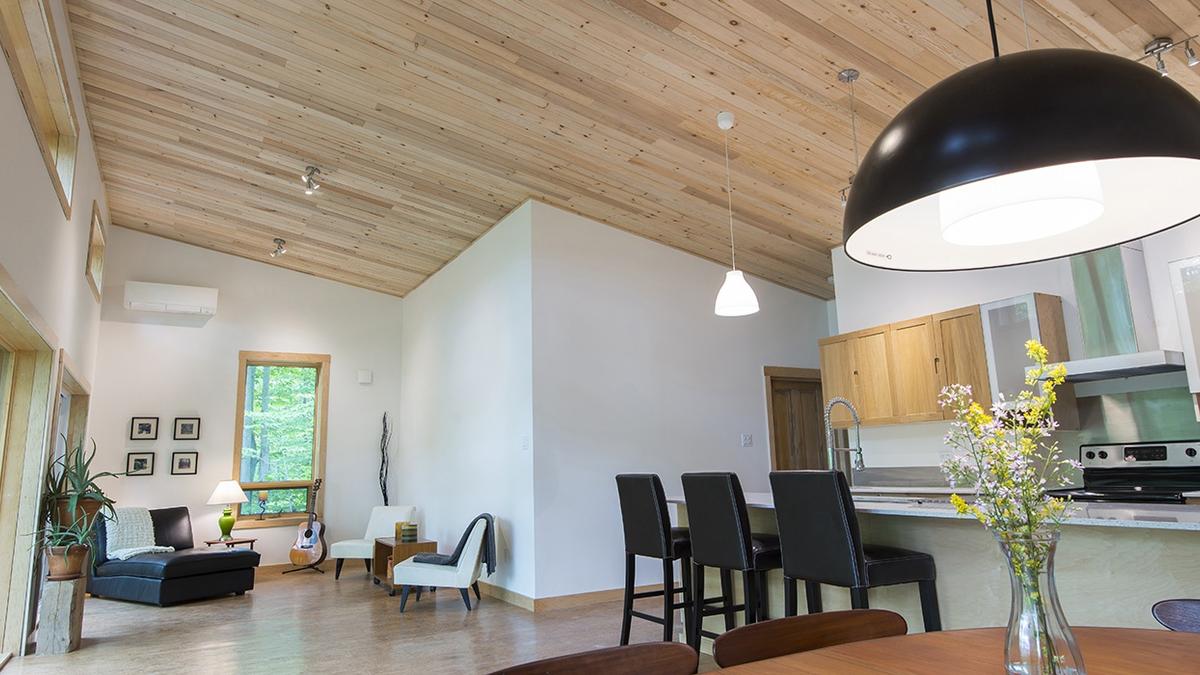A LEED Platinum Home Built for Canada’s Cold Climate
Nestled in the forested hills of Wakefield, Quebec, the Edelweiss House stands as a milestone in sustainable residential construction. Designed and built by Ecohome — a leader in sustainable building education — the project was conceived as a living laboratory: proof that advanced energy performance, for effective cold weather ventilation.
Completed in 2015, Edelweiss became the first home in Canada — and only the second in the world — to achieve LEED v4 Platinum certification, setting a benchmark for high-performance homebuilding in cold climates.
Sustainable Design and Cold Weather Ventilation
The Edelweiss House demonstrates that sustainable design doesn’t require complexity — and that effective cold weather ventilation can be achieved through simplicity, balance, and thoughtful design. Passive-solar orientation, super-insulated walls, and non-toxic materials combine to maintain steady indoor comfort through Quebec’s long, cold winters — where temperatures often plunge below –25°C.
By emphasizing building science rather than mechanical systems, Ecohome proved that durable, low-energy, and affordable housing is achievable using standard materials available in Canada. The result is a practical model for high-performance living that continues to influence sustainable home design nationwide.
Integrating Lunos Decentralized Ventilation
To preserve indoor air quality within its airtight envelope, the Edelweiss House integrated Lunos decentralized and ductless heat-recovery ventilation (HRV). The system provides balanced, continuous airflow without ductwork — a quiet and efficient solution ideal for airtight, energy-efficient homes built to LEED or Passive House standards and proven to support cold weather ventilation performance.
This installation reflects the growing adoption of decentralized HRV systems in Canadian sustainable housing, offering an alternative to traditional ducted ventilation while maintaining comfort and energy efficiency in even the coldest regions.

Watch: Ecohome demonstrates the Lunos HRV installation used in the Edelweiss House project.
This short video shows how decentralized ventilation can be integrated into a high-performance building envelope — a practical example of efficient, balanced air exchange in a cold-climate home.
Designed for the Canadian Building Code
From Wakefield’s sub-zero winters to coastal rainforests and prairie winds, every region of Canada demands ventilation systems that perform reliably in real-world conditions. Projects like Edelweiss show how ductless ventilation delivers both comfort and code-level performance. This approach to cold weather ventilation aligns with the evolving requirements of Canada’s National Building Code.
Lunos Canada continues to build on that foundation, advancing decentralized ventilation technologies toward full compliance with Canada’s National Building Code and CSA C439. This milestone will redefine how ductless HRV systems are integrated into Canadian homes and modular construction — ensuring performance that meets the country’s most demanding standards.
Continuing the Legacy
Today, the Edelweiss House remains an educational hub for sustainable design — demonstrating what comfort and energy performance can look like in a modern, efficient home. Its legacy extends well beyond its walls, inspiring projects across Canada that apply the same principles of simplicity, health, and resilience — often with Lunos HRV systems at their core.
As projects like the Edelweiss House continue to shape the future of Canadian homebuilding, Lunos Canada remains focused on advancing decentralized ventilation systems that perform where it matters most — in cold climates, under real conditions, and in full alignment with national standards.
To learn more about how Lunos ventilation systems can support your next sustainable project, use the button below to connect with our team through the Inquiry Page.

0 commentaire